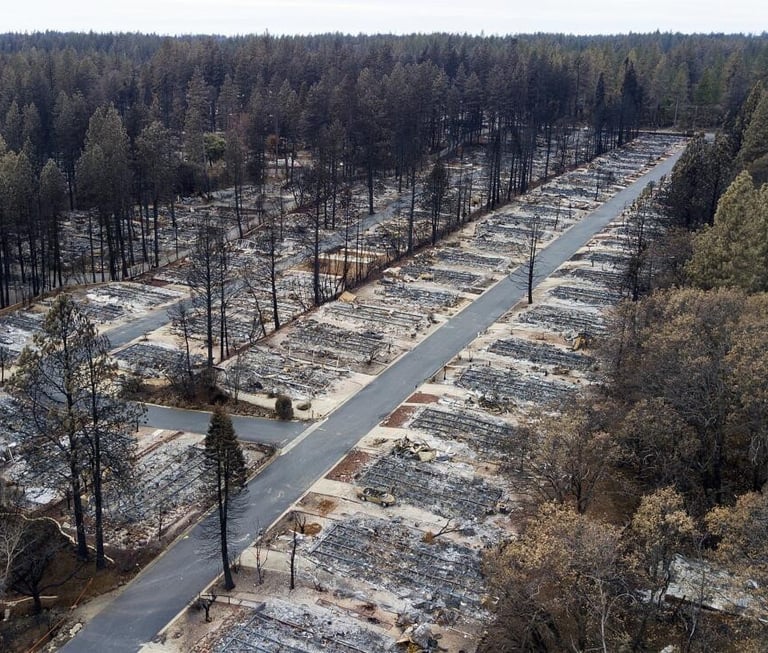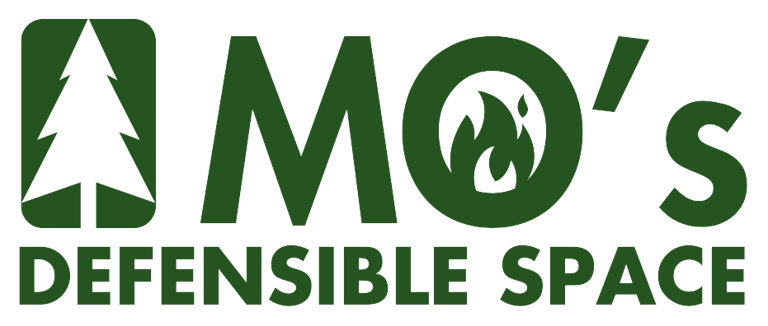Common Defensible Space Myths and Misconceptions
Increasingly destructive wildfires and efforts for greater wildfire preparedness practices have pushed the term "defensible space" into the spotlight. Without proper understanding, many myths and misconceptions about defensible space have been perpetuated. We’re going to explore and dispel some of the most popular myths.


1. Myth: Creating defensible space means I must remove all of my vegetation.
FACT: Proper and effective defensible space practices encourage having native, low-fire risk vegetation, trees, and shrubs! It all just needs to be properly maintained.
The only area that vegetation of any kind is discouraged is in Zone 0, the first 5 ft. around your house. But even in this zone you can have low-growing, leafy, high-moisture content vegetation. Your flowers and vegetable garden are perfectly fine! If you have perennials, like mule's ear, it's important in the fall to remove dead/dry material, as that is a high fire hazard.
Once you move outside of Zone 0, vegetation is important to have. Vegetation, especially native vegetation, plays a vital ecological role in your yard and beyond. They help prevent erosion, manage run-off, maintain healthy soils, and more!
The vegetation in Zone 1 & Zone 2 (5-30 ft. & 30-100 ft. from your home, respectively) needs to be properly spaced and ladder fuels need to be eliminated. This prevents the spread of fire from shrub to shrub, or shrub to tree. When properly managed, vegetation is a vital aspect of your property.
2. Myth: Large trees are the greatest fire hazard on my property.
FACT: Your large trees, especially native conifers, are fire-adapted species, and are probably more likely to survive a wildfire than anything else on your property.
90% of structures are ignited from flying embers, often from fires more than a mile away. They ignite surface fuels like mulch, pine needles, and dead grasses; or embers land on and ignite dead vegetation on your roof or in your gutters.
In many instances, houses will catch on fire while their surrounding trees escape completely unscathed.
Contrary to popular belief, most fires in the US spread with low-intensity. These low-intensity fires burn through surface fuels and move quickly. When these fires reach populated areas, the large trees, if ladder fuels have been managed, are not at high risk of igniting. Instead, the fire is far more likely to move past the large trees, finding the vulnerable points of your landscape like dead grasses and vegetation, pine needles, or combustible mulch.
If in good health, large trees are actually very helpful to defensible space. They provide shade to your property, keeping moisture high and temperature low in your soil and plants!
This concept has been heavily studied by Jack Cohen, a Research Scientist with the USDA. Cohen has spent decades studying home ignition points at the Fire Lab in Missoula, MT. Through this research, Cohen and his team developed the 3 Defensible Space zones (Zone 0, 1, & 2), as the most comprehensive tool for protecting your home from wildfires.
3. Myth: The best defensible space practice is mastication and mulching.
FACT: Masticating, a method of vegetation management that uses a skid-steer or excavator, can cause more harm than good. Combined with mulching, chipping or grinding woody biomass, these practices can leave flammable material on your property.
To consider with mastication:
Bringing an excavator onto your property can lead to issues with soil health and erosion control.
Masticating can leave slash and debris on your property that can pose as a severe fire risk to your structure.
Mastication can increase growth of non-native, invasive, high-fire risk species on your property.
To consider with mulching:
Mulch is flammable. Even the natural biomass from a chipping project in your backyard. Even if your mulch has been treated with fire retardant.
The only mulches or ground cover that are NOT flammable are inorganic mulches like gravel, granite, or rocks.
A comprehensive study at the University of Reno Nevada concluded that flammable mulch should never be within 5 feet of your home and should not be used in a “widespread or continuous” manner within 30 feet of a structure.
4. Myth: Creating defensible space is very expensive.
FACT: Some of the most effective defensible space actions, can be done by residents at little or no cost.
According to research from experts including Jack Cohen (our hero and Research Physical Scientist with the USDA), one of the most important things that can be done around a home is the creation of a 5 ft. non-combustible zone around the entire perimeter of the house.
Creating a 5 ft. non-combustible zone, for most people, involves cleaning up and putting away combustible storage, removing accumulated debris, and removing high-fire risk vegetation.
What ends up being the greatest cost to homeowners is the removal of their large trees. As previously stated, if the large tree is in good health, it should not be removed!
Defensible space is nuanced but not complicated! Most able-bodied folks can perform most of their defensible space work. MO's is always available to consult with residents looking to perform their own defensible space work; and, of course, we can perform the work for you!
5. Myth: Defensible space will ruin the aesthetics of my property.
FACT: Defensible space involves the act of maintaining healthy vegetation, removing dead/dying vegetation, and cleaning up debris. These actions increase the aesthetic value of a landscape!
Many residents and homeowners rate their property more aesthetically pleasing after defensible space work has been performed.
For folks that enjoy the feeling of living in the forest and are hesitant to create defensible space for fear of losing that, defensible space does not detract from that atmosphere. In fact, it can enhance it. With proper maintenance and spacing, plants and trees have less competition for resources and are more likely to thrive, grow larger, and grow healthier.
We must remember that in the Sierra Nevada, we are living in a fire-adapted landscape. Fire occurs naturally and regularly here, and our landscapes rely on it as part of their life cycle. On our properties, we must act as the fire would, pruning and removing what would've been burned in a fire, so that our landscape can healthily thrive.
6. Myth: Defensible space is bad for native plants and pollinators.
FACT: You can have a healthy, native landscape that is lush and fire resilient.
By having well-maintained and irrigated plants, you can make your landscape more resistant to fire AND protect our pollinators.
The highest fire risk plants, like juniper and arborvitae, do not support biodiversity and are non-native. So, removing these high fire risk plants and replacing them with better selections not only increases your fire protection, but it also provides more opportunity to pollinators.
Works Cited:
Baker, W.L.; Hanson, C.T.; Williams, M.A.; DellaSala, D.A. Countering Omitted Evidence of Variable Historical Forests and Fire Regime in Western USA Dry Forests: The Low-Severity-Fire Model Rejected. Fire 2023, 6, 146.
Deneke, F. 2002. Creating wildfire-defensible spaces for your home and property. University of Arizona Cooperative Extension. AZ1290. Tucson, AZ. 4p.
“Dr. Chad Hanson on Debunking Wildfire Myths: October 2021 Talk for Pasadena Audubon Society.” Www.youtube.com, 2021, www.youtube.com/watch?v=aIr_nEyuKt0.
Gottfried, Gerald. Assessing Mechanical Mastication and Thinning-Piling-Burning Treatments on the Pinyon-Juniper Woodlands of Southwestern Colorado. 2011.
Mercker, D., C. Reese and W. K. Clatterbuck. 2010. Landscaping guidelines to protect your home from wildfire. University of Tennessee Extension. SP685. Knoxville, TN. 6p.
Morse, Bonnie . “Save the Bees and Save Your Home!” Www.youtube.com, 2021, youtu.be/gc4O0Vewu-s.
Neal, Suzanne, et al. TREE THINNING TREATMENTS ALTER SOIL PROPERTIES, ARBUSCULAR MYCORRHIZAL FUNGI and UNDERSTORY PLANT COMMUNITIES. 2007.
Owen, Suzanne M., Carolyn H. Sieg, and Steven T. Overby. "Do Mastication Treatments Enhance Exotic Invasive Species?." (2015).
Potts, Jennifer B., and Scott L. Stephens. “Invasive and Native Plant Responses to Shrubland Fuel Reduction: Comparing Prescribed Fire, Mastication, and Treatment Season.” Biological Conservation, vol. 142, no. 8, Aug. 2009, pp. 1657–1664.
Quarles, S., Smith, E. 2011, The Combustibility of Landscape Mulches, Extension | University of Nevada, Reno, SP-11-04
Rogstad, A., T. DeGomez, C. Hayes, J. Schalau, and J. Kelly. 2007. Comparing the ignitability of mulch materials for a firewise landscape. University of Arizona, College of Agriculture and Life Sciences Bulletin, AZ1440. 5p.
Syphard Alexandra D., Brennan Teresa J., Keeley Jon E. (2014) The role of defensible space for residential structure protection during wildfires. International Journal of Wildland Fire 23, 1165-1175.














